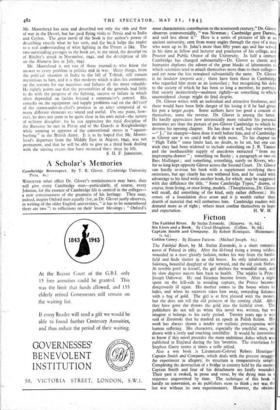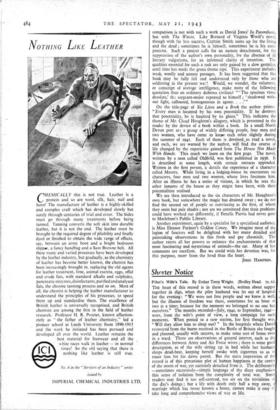Fiction
Captain Smith and Company. By Robert Henriques. (Heinemann.
75. 6d.) Golden Coney. By Eleanor Farjeon. (Michael Joseph. 6s.)
The Faithful River, by M. Stefan Zeromski, is a short romantic novel of Poland in 1863. After the ill-fated rising a young soldier, wounded in a most ghastly fashion, makes his way from the battle- field and finds shelter io an old house. Its only inhabitants are Salomea, beautiful daughter of the steward, and the old cook Stefan. At terrible peril to herself, the girl shelters the wounded man, and by slow degrees nurses him back to health. The soldier is Prince Joseph Odrowaz. He and Saloniea become lovers. • After a night spent on the hill-side in avoiding capture, the Prince becomes dangerously ill again. His mother comes to the house where he hides, and when he recovers takes him away, rewarding Salomea with a bag of gold. The girl is at first pleased with the money, but she does not tell the old princess of the coming child. After they have- gone she throws the gold into the faithful river. The publishers do not tell us when this novel was written, but we imagine it belongs. to his early period. Twenty years ago it was said of Zeromski that he marked an epoch in Polish fiction. His work has always shown a tender yet realistic preoccupation with human suffering. His characters, especially the youthful ones, are drawn with a lively and touching sensibility. It would be interesting to know if this novel precedes the more ambitious Ashes which was published in England during the late 'twenties. The translation by Stephen Garry seems at times a trifle stilted.
Also a war book is Lieutenant-Colonel Robert Henriques' Captain Smith and Company, which deals with the present struggle. An experiment in allegory, its structure is comparatively simple. Completing the destruction of a bridge-in country held by the enemy, Captain Smith and four of his detachment are fatally wounded. Their past is evoked, in prose and verse, by the dying man in a sequence ungoverned by time. The technique of this book is hardly an innovation, as its publishers seem to think ; nor was the last war without its own experimentors. However, the obvious
comparison is not with such a work as David Jones' In Parenthesis, but with The Waves. Like Bernard of Virginia Woolf's novel, though with far less success, Captain Smith sums up for the living and the dead ; sometimes he is himself, sometimes he is his com- panions. Such a project calls for an austere detachment, for the suppression of the author's own personality, for the absence of all literary vulgarisms, for an infolined clarity of intention. The qualities essential for such a task are only gained by a slow gestation until time has made the green theme ripe. This experiment includes weak, woolly and uneasy passages. It has been suggested that this book may be fully felt and understood only by those who are soldiering in the present war! Would, we wonder, the volunteer, or conscript of average intelligence, make more of the following quotation than an ordinary dubious civilian? " The-spacious vistas desolate,' dr:, sergeant-major repeated to himself ; shadowed with- out light, calloused, homogeneous in agony. . . "
On the title-page of Six Lives and a Book the author prints: " Every man is haunted by his own potentiality. If he destroys that potentiality, he is haunted by its ghost" This indicates the theme of Mr. Claud Houghton's allegory, which is presented to the reader by the device of a book within a book. In a small North Devon port arz a group of widely differing people, four men and two women, who have come to know each other slightly during the summer of 1941. Each of them is destined to read a novel, and each, we are warned by the author, will find the course of life changed by the experience gained from The House Not Made With Hands. This much we learn on the first page. The novel, written by a man called Oldfield, was first published in 1936. It is described at some length, with certain extracts appended. Written in the first person, it details the experience of a character called Mayers. While living in a lodging-house he encounters six characters, four men and two women, whose lives fascinate him. After an illness he has a series of visions, in which he sees the other inmates of the house as they might have been, with their potentialities realised. We are then introduced to the six characters of Mr. Houghton's own book, but somewhere the magic has drained away ; we- do not find the second set of people so convincing as the first, of whom they seem but pale shades ; nor are we convinced that their problems could have worked out differently, if Fenella Purvis had never gone to Marleham's Public Library.
Another experiment, again by a specialist for a specialised audience, is Miss Eleanor Farjeon's Golden Coney. We imagine most of the legion of fanciers will be delighted with her many detailed and painstaking observations in this fresh and gay chronicle. The author exerts all her powers to enhance the enchantments of that most fascinating- and mysterious of animals—the cat. Many of her comments are excellent. But we could wish her devotion was, for this 'purpose, more from the head than the heart. ,
JOHN HAMPSON.



























 Previous page
Previous page